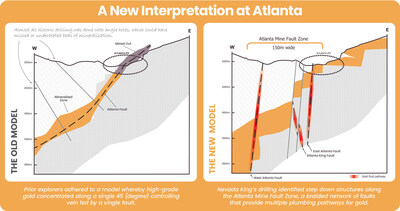VANCOUVER, BC, Sept. 5, 2023 /PRNewswire/ - Nevada King Gold Corp. (TSXV: NKG) (OTCQX: NKGFF) ("Nevada King" or the "Company") is pleased to announce assay results from two vertical reverse circulation ("RC") holes recently completed at its Atlanta Gold Mine Project located 264km northeast of Las Vegas, Nevada, in the prolific Battle Mountain Trend. The two holes reported today are plotted below in plan and along an updated Section 22-6N(3), initially released on January 6, 2023, updated on March 20, 2023 and again on July 20, 2023 (Figures 2-3).
Highlights:
Hole No.
| From (m)
| To (m)
| Interval (m)
| Au (g/t)
| Ag (g/t)
|
AT23WS-35
| 201.2
| 315.5
| 114.3
| 1.58
| 3.7
|
Includes
| 263.7
| 288.1
| 24.4
| 3.61
| 6.1
|
AT23WS-39
| 224.1
| 315.5
| 91.5
| 0.96
| 3.9
|
|
|
|
|
|
|
|
Table 1: Holes released today. Mineralization occurs along near-horizontal horizons with true mineralized thicknesses in vertical holes estimated to be 95% to 100% of reported drill intercept length.
|
- Today's intervals are the westernmost holes drilled by Nevada King at Atlanta to date and have successfully identified high-grade gold mineralization in the western extents of the West Atlanta Graben ("WAG") close to the West Atlanta Fault #2 ("WAF2").
- 1.58 g/t Au over 114.3m including 3.61 g/t Au over 24.4m in AT23WS-39 is appreciably higher-grade than surrounding holes, injecting high-grade into the surrounding thick blanket of gold mineralization. This is similar to previously released 3.39 g/t Au over 100.6m in AT23HG-30 (July 20, 2023), located 125m to the east of AT23WS-39 and also plotted on Section 22-6N(3).
- Together these holes illustrate the effectiveness of Nevada King's drill targeting based on its new geological model, which outlines a series of high-angle faults that divide the mineralized zone into fault-bounded blocks or domains, in turn creating numerous fluid pathways each capable of localizing high-grade gold mineralization throughout the Atlanta deposit. This is a significant departure from the historical Atlanta model, which envisioned a single 45 degree vein structure (see Figure 1 below) with no fault offsets or high-grade feeders other than the 45 degree vein zone itself.

Cal Herron, Exploration Manager of Nevada King, stated, "These new results continue to expand WAG mineralization westward with increasing gold grades and thicknesses. Referring to Figure 3, there are seven historical Kinross holes drilled in the WAG along Section 22-6N(3) that average 0.89 g/t Au with an average intercept thickness of 65m. The same section length now includes ten holes drilled by Nevada King with an average grade of 1.39 g/t Au and an average intercept thickness of 121m, representing a 56% increase in grade and an 86% increase in thickness. High-grade intercepts like 114.3m @ 1.58 g/t Au in AT23WS-39 and 100.6m @ 3.39 g/t Au in AT23HG-30 are important as they strongly influence this ten-hole average. We believe that intercepting these higher-grade zones or feeders concentrated along the high-angle faults is the key to realizing the full potential of the Atlanta deposit and this same pattern is playing out along other section lines to the north and south as they are progressively filled-in with new holes. Table 4 below summarizes averaged drill hole intercepts for the Company's holes and for historical holes that were included in the Gustavson 2020 resource model along Section22-6N(3). This provides an interesting comparison of Au-Ag grades and thicknesses within the WAG."


Hole No.
| From (m)
| To (m)
| Interval (m)
| Au (g/t)
| Ag (g/t)
|
AT23HG-30
| 169.2
| 269.8
| 100.6
| 3.39
| 9.6
|
Includes
| 227.1
| 240.9
| 13.7
| 12.67
| 38.2
|
And
| 294.2
| 373.5
| 79.3
| 0.27
| 0.4
|
AT23HG-28
| 150.9
| 224.1
| 73.2
| 2.67
| 13.6
|
Includes
| 204.3
| 216.5
| 12.2
| 7.59
| 45.9
|
AT23HG-22
| 181.4
| 323.2
| 141.8
| 0.55
| 4.0
|
AT22SE-4
| 146.3
| 327.7
| 181.4
| 1.03
| 3.8
|
AT22SE-42
| 122.0
| 201.2
| 79.3
| 1.50
| 1.4
|
And
| 234.8
| 318.6
| 83.8
| 0.48
| 3.6
|
Aggregate
| 122.0
| 318.6
| 163.1
| 0.98
| 2.5
|
AT22NS-69
| 89.9
| 135.7
| 45.7
| 1.57
| 8.5
|
AT22NS-68
| 134.1
| 163.1
| 29.0
| 4.03
| 21.2
|
Including
| 157.0
| 160.1
| 3.1
| 10.03
| 18.5
|
AT22HG-16
| 163.1
| 170.7
| 7.6
| 2.98
| 7.5
|
And*
| 196.6
| 292.7
| 96.0
| 1.38
| 3.1
|
AT22HG-17*
| 146.3
| 311.0
| 165.5
| 0.92
| 3.0
|
AT22HG-19*
| 155.5
| 233.2
| 77.7
| 1.92
| 28.1
|
Including
| 207.3
| 224.1
| 16.8
| 4.76
| 86.8
|
AT21-41B*
| 38.1
| 73.2
| 35.0
| 1.17
| 11.3
|
AT21-50A^
| 141.8
| 178.3
| 36.5
| 1.00
| 17.91
|
AT22RC-11
| 0
| 33.5
| 33.5
| 1.28
| 0.5
|
AT22RC-12^
| 0
| 57.9
| 57.9
| 1.38
| 14.0
|
|
|
|
|
|
|
|
Table 2: Previously reported holes drilled by Nevada King along Section 22-6N(3). True thickness of gold mineralization is estimated to be 95% to 100% of the reported intercept length in vertical holes. *Denotes hole that bottomed in mineralization. ^Denotes angle hole.
|
Hole No.
| From (m)
| To (m)
| Interval (m)
| Au (g/t)
| Ag (g/t)
|
KR98-2^
| 265.2
| 304.9
| 39.7
| 0.96
| 6.82
|
KR98-7^*
| 204.3
| 257.6
| 53.4
| 1.36
| 3.85
|
KR98-9^
| 170.9
| 190.5
| 19.8
| 0.20
| 0.1
|
KR98-10^
| 242.3
| 330.8
| 88.5
| 0.77
| 1.8
|
KR98-11^*
| 244
| 343
| 99
| 0.81
| 3.02
|
KR98-13^*
| -
| -
| -
|
| -
|
AR-27*
| 161.6
| 260.7
| 99.1
| 0.73
| 1.84
|
AC-4^
| 167.7
| 224.1
| 56.4
| 1.25
| 7.31
|
Table 3: Historical holes used in updated Section 22-6N. KR98 series holes were drilled by Kinross in 1998. AR and AC series holes were drilled by Goldfields in 1991. ^Denotes angle holes. *Denotes holes that bottomed in mineralization.
|
Operator
| West Atlanta Graben
| Atlanta Mine Fault Zone
|
| No. of
Holes
| Average Au eq.
(g/t)
| Average
Thickness (m)
| No. of
Holes
| Average Au eq
. (g/t)
| Average
Thickness (m)
|
NKG
| 10
| 1.47
| 121
| 6
| 1.79
| 39.7
|
Historical
| 7
| 0.933
| 65
| None
| -
| -
|
Table 4. Comparison of Nevada King and historical drill results along section line 22-6N(3), using weighted averages. Gold equivalents calculated using Au/Ag prices of $1,943/oz and $24.77/oz, respectively (Aug 30, 2023 US$ spot prices).
|
Qualified Person
The scientific and technical information in this news release has been reviewed and approved by Calvin R. Herron, P.Geo., who is a Qualified Person as defined by National Instrument 43-101 ("NI 43-101").
About Nevada King Gold Corp.
Nevada King is the third largest mineral claim holder in the State of Nevada, behind Nevada Gold Mines (Barrick/Newmont) and Kinross Gold. Starting in 2016 the Company has staked large project areas hosting significant historical exploration work along the Battle Mountain trend located close to current or former producing gold mines. These project areas were initially targeted based on their potential for hosting multi-million-ounce gold deposits and were subsequently staked following a detailed geological evaluation. District-scale projects in Nevada King's portfolio include (1) the 100% owned Atlanta Mine, located 100km southeast of Ely, (2) the Lewis and Horse Mountain-Mill Creek projects, both located between Nevada Gold Mines' large Phoenix and Pipeline mines, and (3) the Iron Point project, located 35km east of Winnemucca, Nevada.
The Atlanta Mine is a historical gold-silver producer with a NI 43-101 compliant pit-constrained resource of 460,000 oz Au in the measured and indicated category (11.0M tonnes at 1.3 g/t) plus an inferred resource of 142,000 oz Au (5.3M tonnes at 0.83 g/t). See the NI 43-101 Technical Report on Resources titled "Atlanta Property, Lincoln County, NV" with an effective date of October 6, 2020, and a report date of December 22, 2020, as prepared by Gustavson Associates and filed under the Company's profile on SEDAR+ (www.sedarplus.ca).
NI 43-101 Mineral Resources at the Atlanta Mine
Resource Category
| Tonnes
(000s)
| Au Grade
(ppm)
| Contained Au
Oz
| Ag Grade
(ppm)
| Contained Ag
Oz
|
Measured
| 4,130
| 1.51
| 200,000
| 14.0
| 1,860,000
|
Indicated
| 6,910
| 1.17
| 260,000
| 10.6
| 2,360,000
|
Measured + Indicated
| 11,000
| 1.30
| 460,000
| 11.9
| 4,220,000
|
Inferred
| 5,310
| 0.83
| 142,000
| 7.3
| 1,240,000
|
Please see the Company's website at www.nevadaking.ca.
Neither the TSX Venture Exchange nor its Regulation Services Provider (as that term is defined in the policies of the TSX Venture Exchange) accepts responsibility for the adequacy or accuracy of this release.
Cautionary Statements Regarding Forward Looking Information
This news release contains certain "forward-looking information" and "forward-looking statements" (collectively "forward-looking statements") within the meaning of applicable securities legislation. All statements, other than statements of historical fact, included herein, without limitation, statements relating the future operations and activities of Nevada King, are forward-looking statements. Forward-looking statements are frequently, but not always, identified by words such as "expects", "anticipates", "believes", "intends", "estimates", "potential", "possible", and similar expressions, or statements that events, conditions, or results "will", "may", "could", or "should" occur or be achieved. Forward-looking statements in this news release relate to, among other things, the Company's exploration plans and the Company's ability to potentially expand mineral resources and the impact thereon. There can be no assurance that such statements will prove to be accurate, and actual results and future events could differ materially from those anticipated in such statements. Forward-looking statements reflect the beliefs, opinions and projections on the date the statements are made and are based upon a number of assumptions and estimates that, while considered reasonable by Nevada King, are inherently subject to significant business, economic, competitive, political and social uncertainties and contingencies. Many factors, both known and unknown, could cause actual results, performance or achievements to be materially different from the results, performance or achievements that are or may be expressed or implied by such forward-looking statements and the parties have made assumptions and estimates based on or related to many of these factors. Such factors include, without limitation, the ability to complete proposed exploration work, the results of exploration, continued availability of capital, and changes in general economic, market and business conditions. Readers should not place undue reliance on the forward-looking statements and information contained in this news release concerning these items. Nevada King does not assume any obligation to update the forward-looking statements of beliefs, opinions, projections, or other factors, should they change, except as required by applicable securities laws.

 View original content to download multimedia:https://www.prnewswire.com/news-releases/nevada-king-intercepts-1-58-gt-au-over-114-3m-including-3-61-gt-over-24-4m-extends-high-grade-mineralization-further-westward-at-atlanta-301917183.html
View original content to download multimedia:https://www.prnewswire.com/news-releases/nevada-king-intercepts-1-58-gt-au-over-114-3m-including-3-61-gt-over-24-4m-extends-high-grade-mineralization-further-westward-at-atlanta-301917183.html
SOURCE Nevada King Gold Corp.
![]() View original content to download multimedia:https://www.prnewswire.com/news-releases/nevada-king-intercepts-1-58-gt-au-over-114-3m-including-3-61-gt-over-24-4m-extends-high-grade-mineralization-further-westward-at-atlanta-301917183.html
View original content to download multimedia:https://www.prnewswire.com/news-releases/nevada-king-intercepts-1-58-gt-au-over-114-3m-including-3-61-gt-over-24-4m-extends-high-grade-mineralization-further-westward-at-atlanta-301917183.html









